Companion plants can be used to enhance the growth of other plants, improve soil and attract pollinators. But one of the best ways to use companion planting is for organic pest control. If you want to keep pests out of your garden but you don’t want to resort to chemical pesticides, these bug-busting companion plants can help!
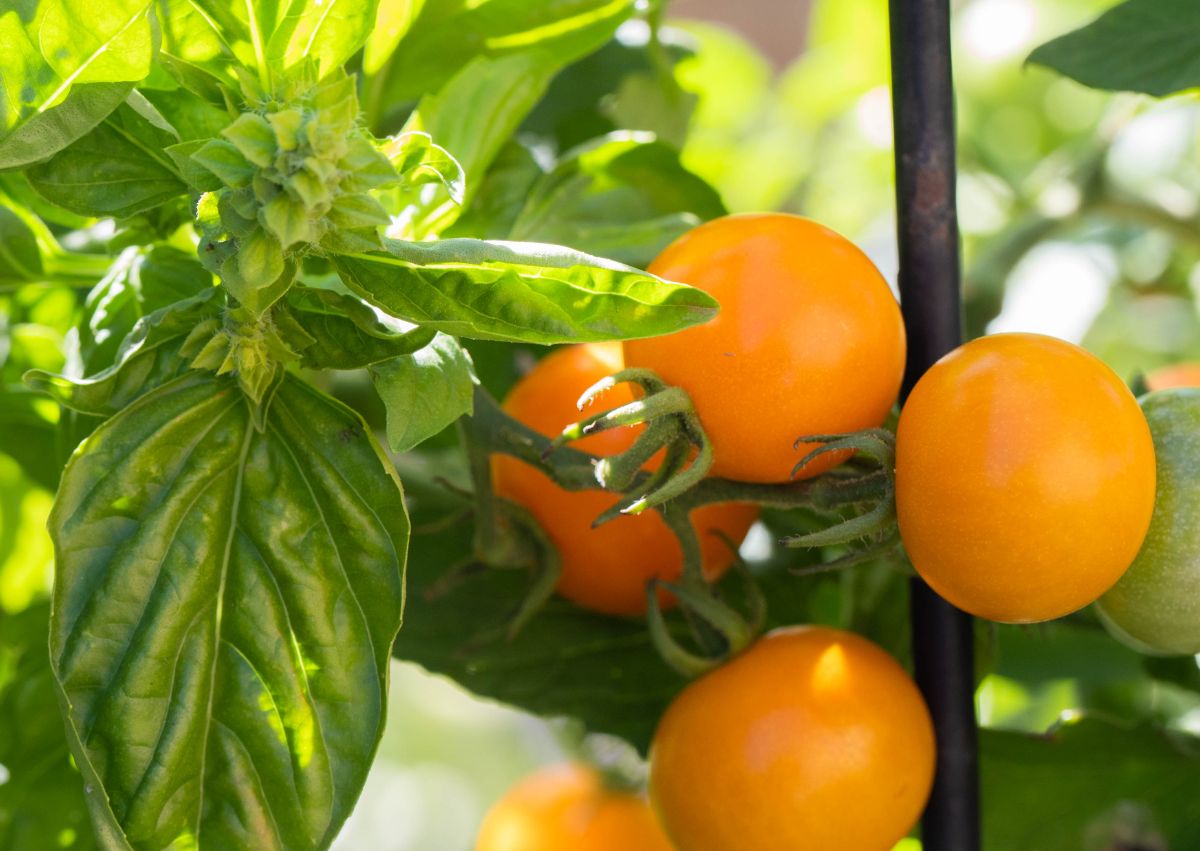
Jump to:
20 best companion plants to grow for natural pest control
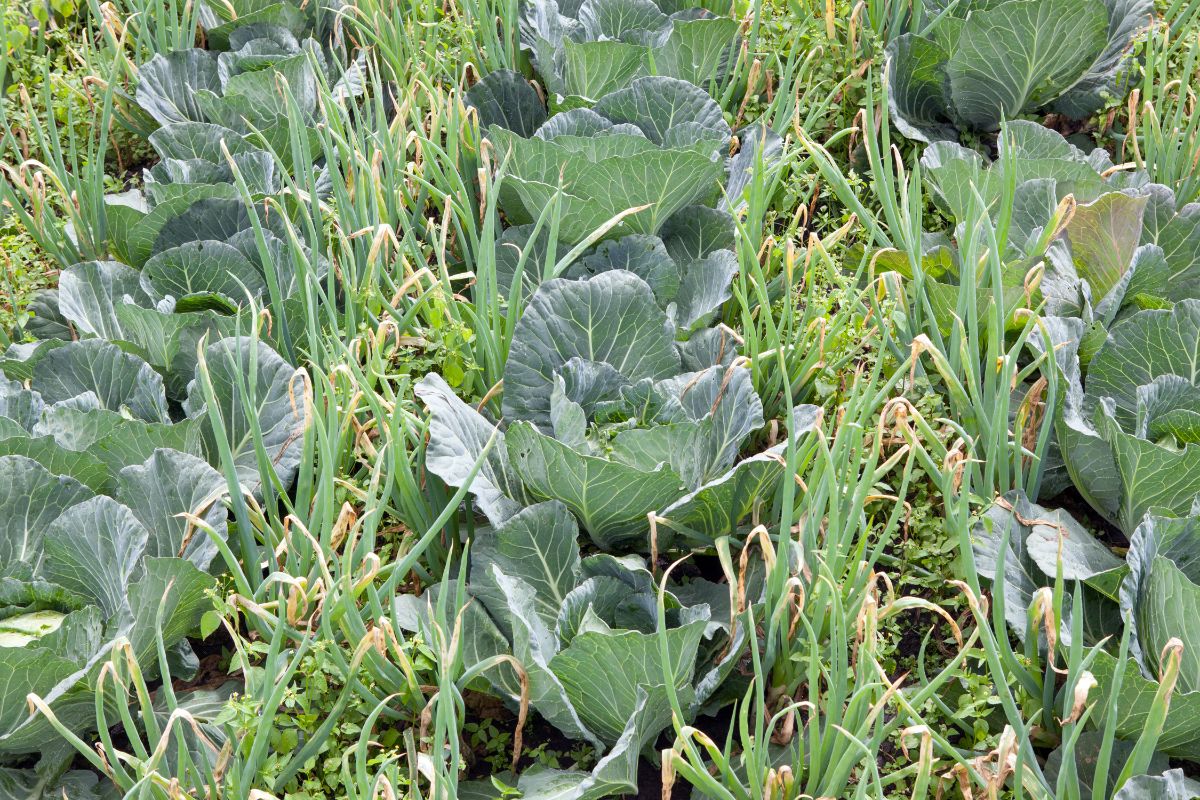
Certain vegetables, herbs, and flowers have strong scents and other properties that make them repellant to an assortment of garden pests. In the list below, you’ll find companion plants to repel beetles, hornworms, and other destructive caterpillars and deer too! Say goodbye to pest damage and say hello to a healthier garden with these top companion plants for natural pest control.
1. Chives
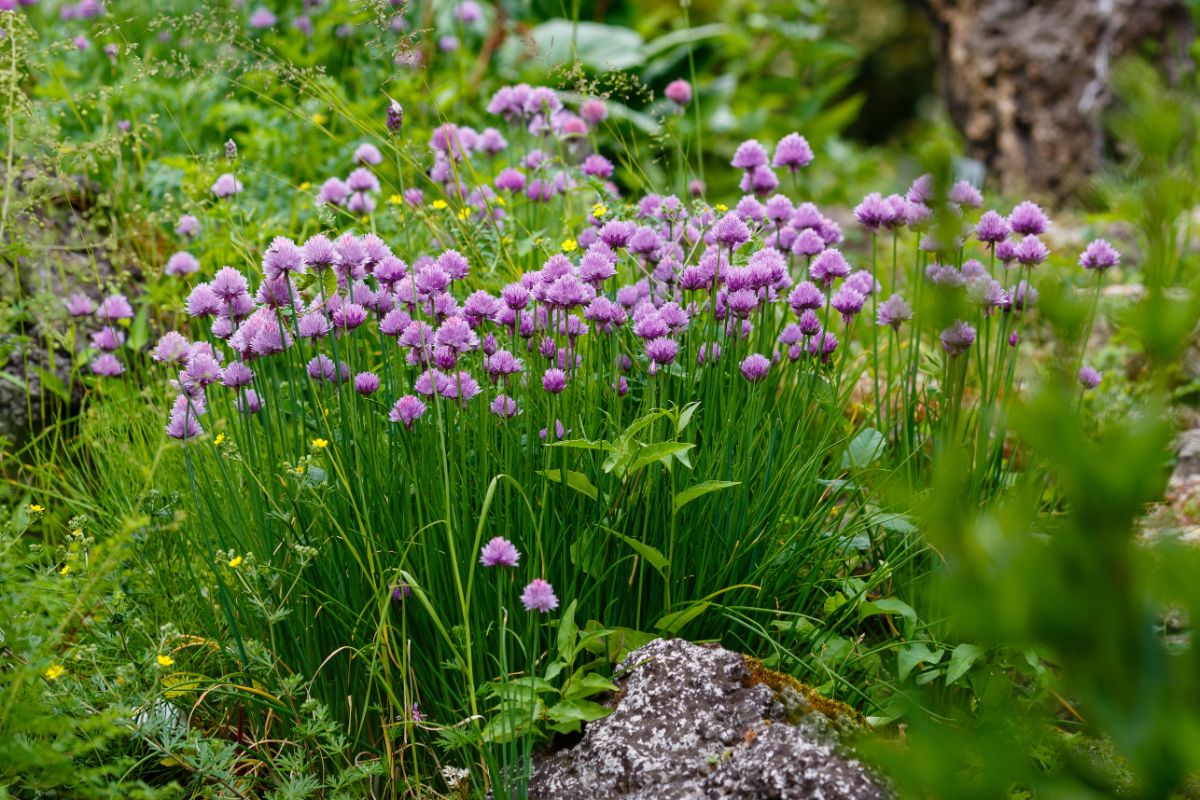
| Plant name: | Chives |
| Growing zone: | Zones 3 to 10 |
| Plant type: | Herb |
| Top pest control use: | Japanese beetle, aphids, cabbage loopers, deer |
| Recommended companions? | Strawberries, roses, brassicas, tomatoes, carrots |
Chives are one of the most popular herbs to grow in home gardens, and their mild, oniony flavor is a must-have on baked potatoes, salads, and casseroles. But what many gardeners don’t realize is that chives are one of the most useful plants to grow for organic pest control. Plus, if you allow them to flower, they’ll lure beneficial insects and pollinators to your garden too!
While chives’ strong aroma can repel a wide variety of pests, chives are mostly known for their ability to repulse Japanese beetles and aphids. This makes chives a perfect companion plant to pair with ornamentals, like roses, but chives can also benefit fruit and vegetable plants too. If you want to get the most use out of growing chives in an edible garden, try pairing them with pest-prone plants like brassicas and strawberries.
2. Basil
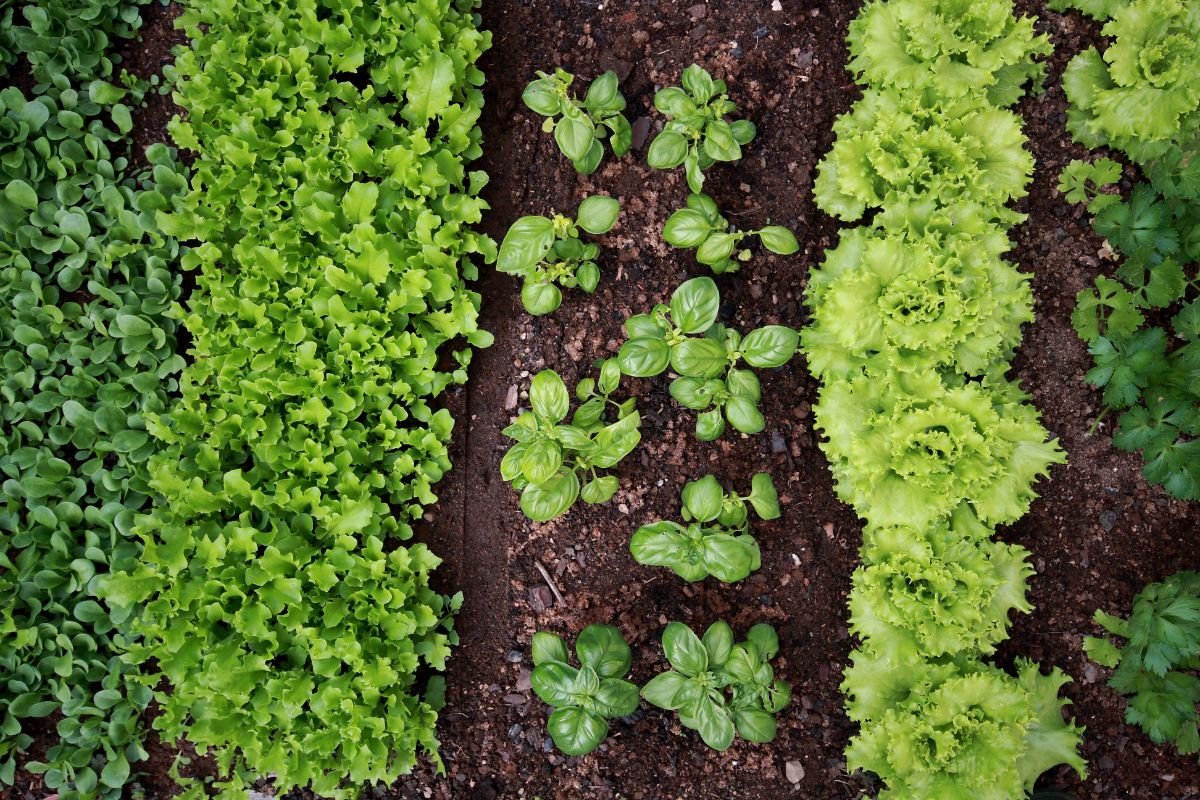
| Plant name: | Basil |
| Growing zone: | Zones 4 to 10 |
| Plant type: | Herb |
| Top pest control use: | Flies, mosquitoes, potato bugs |
| Recommended companions? | Tomatoes and other nightshades, asparagus, root vegetables |
Basil is well-known for being a top companion plant for tomatoes, and growing these two edibles together is said to boost the flavor of both plants. But basil can also grow happily with many other herbs and flowers, and its fragrance can be useful for repelling flies, Colorado potato beetles, and pesky mosquitoes! While all basil varieties have pest-repellent properties, cultivars like cinnamon basil and lemon basil are particularly useful for this purpose.
Since basil is a relatively small plant, you can easily grow it in inground gardens or container planters. And, while Genovese basil is the most popular type of basil for pesto-making, varieties like Thai basil or purple basil can also be fun to grow. Beyond tomatoes, some of the other best companion plants for basil include asparagus, root vegetables, and eggplants.
3. Onions
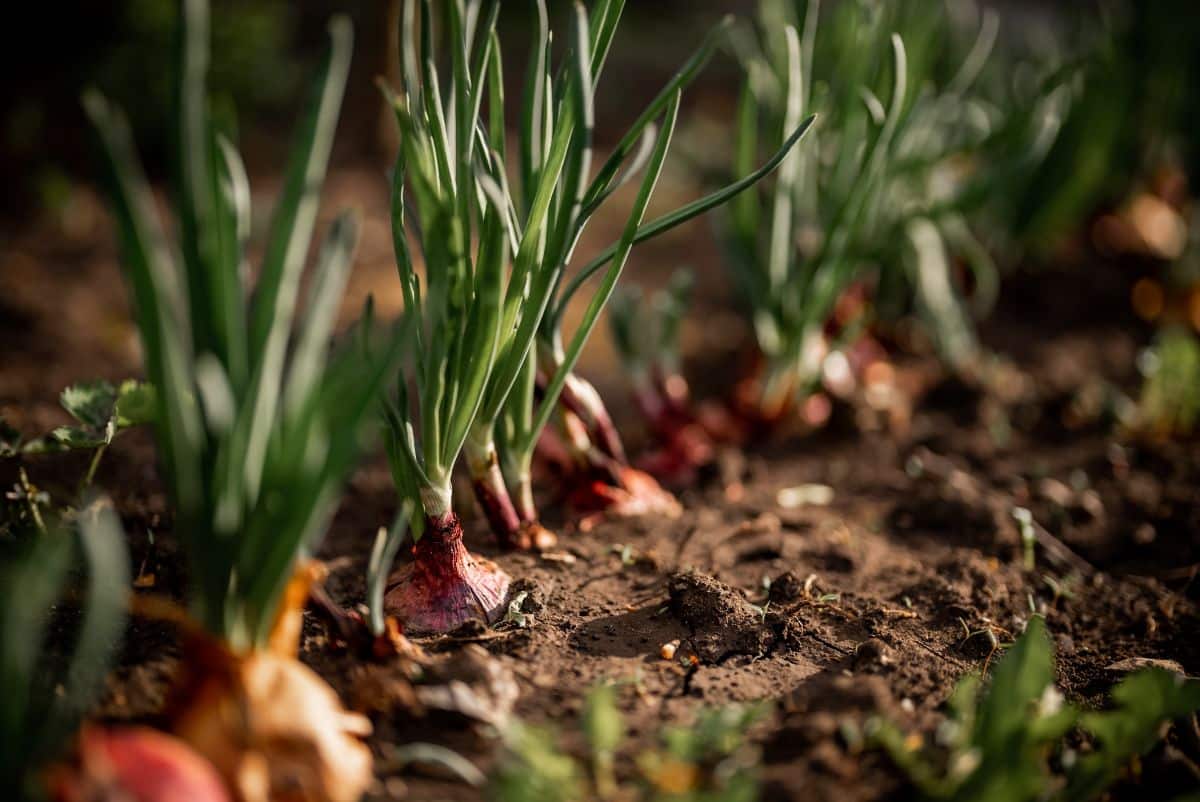
| Plant name: | Onions |
| Growing zone: | All |
| Plant type: | Vegetable |
| Top pest control use: | Various insects, deer, moles |
| Recommended companions? | Carrots, beets, brassicas, strawberries |
Like chives, onions contain a lot of sulfur, which is responsible for their pungent aroma and their strong pest-repelling properties. Onions are multi-purpose companion plants, and they can be used to keep many different pests out of your garden, including various insects, moles, and even deer! That’s why, if you’ve ever struggled with keeping deer out of your garden, you may want to try planting a ring of onions around the perimeter of your beds.
Onions come in a wide range of flavors, and heat levels can vary significantly between onion varieties. Most chefs agree that red onions are the best for fresh eating, while yellow onions are recommended for cooking. But if you don’t like lots of spice, sweet onions have a deliciously mild flavor that can elevate almost any dish!
4. Marigolds
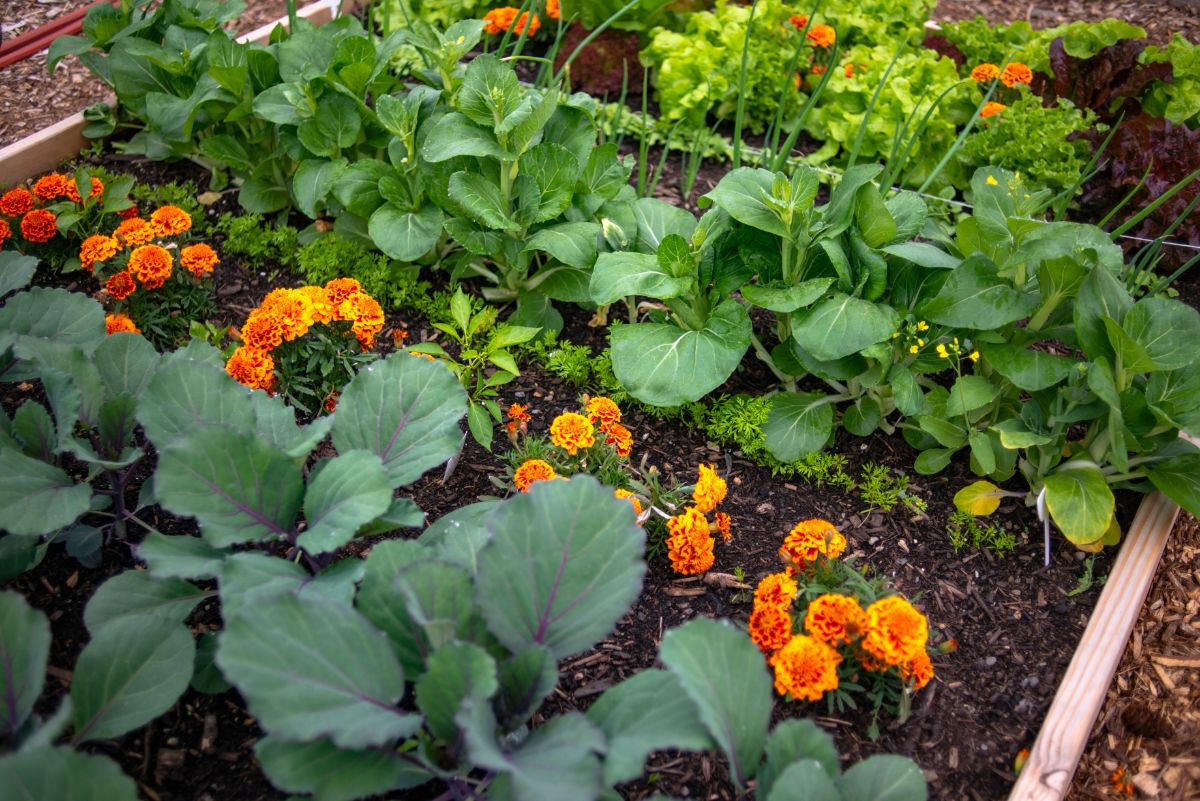
| Plant name: | Marigolds |
| Growing zone: | Zones 2 to 11 |
| Plant type: | Ornamental |
| Top pest control use: | Mexican bean beetles, nematodes, deer, rabbits, aphids |
| Recommended companions? | Nightshades, cucumbers, melons, lettuce, pumpkins |
Marigolds are pretty enough to hold their own in ornamental beds, but marigolds’ fragrant flowers also make them useful for pest control. For this reason, many growers interplant marigolds among their fruit and vegetable beds to keep an assortment of insects, nematodes, deer, and rabbits at bay. Even better, marigolds also come in dwarf sizes that are ideal for container gardens.
Marigolds come in an assortment of colors, including yellow, red, and orange, as well as bi-colored bloom varieties. Blooming from early summer to the hard frosts of fall, marigolds are a long-season flower that can be enjoyed for the better part of the year. If you want to get the most out of growing marigolds as companion plants, use them as a border around your veggie patch or pair them with plants like tomatoes, potatoes, and cucumbers.
5. Nasturtiums
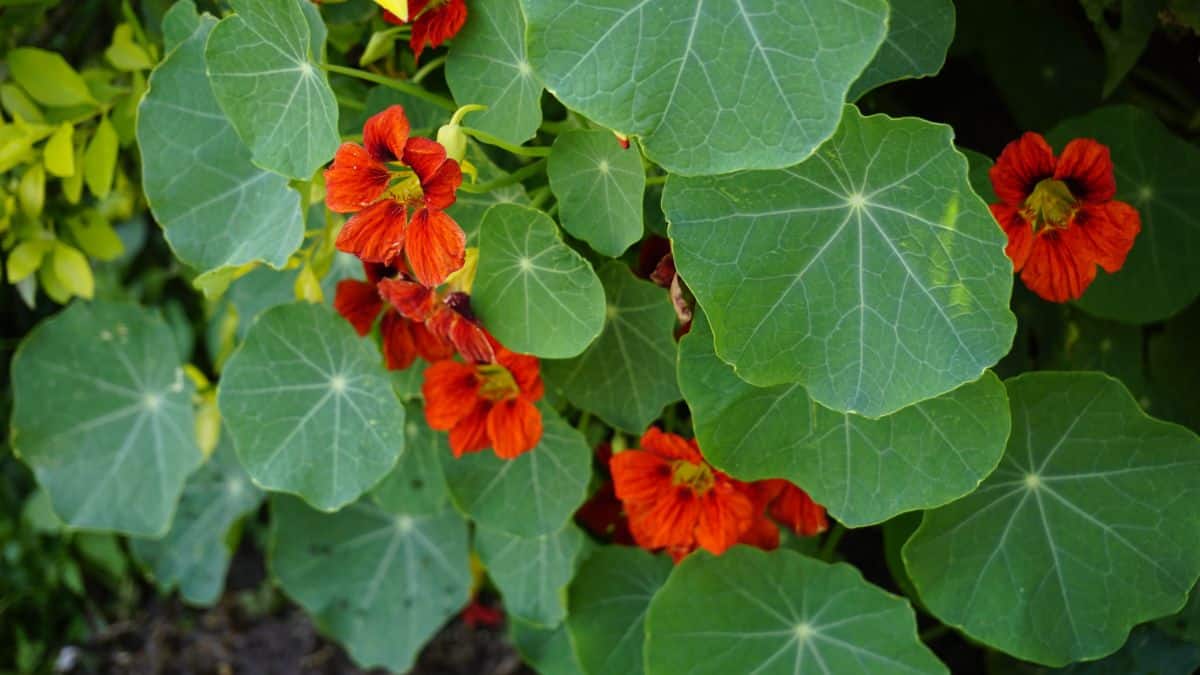
| Plant name: | Nasturtiums |
| Growing zone: | Zones 9 to 11; Grown as an annual in cooler spots |
| Plant type: | Ornamental; Edible |
| Top pest control use: | Aphids, whiteflies, beetles |
| Recommended companions? | Beans, cucumbers, brassicas |
Nasturtiums are another powerfully scented flower with big, bold blooms in various shades of yellow and orange. All parts of nasturtiums are edible, including their leaves, flowers, and seeds, and they make spectacular ornamental plants too. You can find nasturtiums in both mounding and trailing varieties, which can be used differently in gardens and growing containers.
Mounding-type nasturtiums are particularly useful for container gardens, while vining varieties can be trained to grow up trellises, or they can be used as a low-maintenance ground cover for weed suppression. As far as companion planting goes, nasturtiums can repel aphids, whiteflies, and an assortment of destructive beetles. These plants also act as excellent trap crops and lure pests away from more vulnerable fruit and veggies.
6. White Icicle Radishes
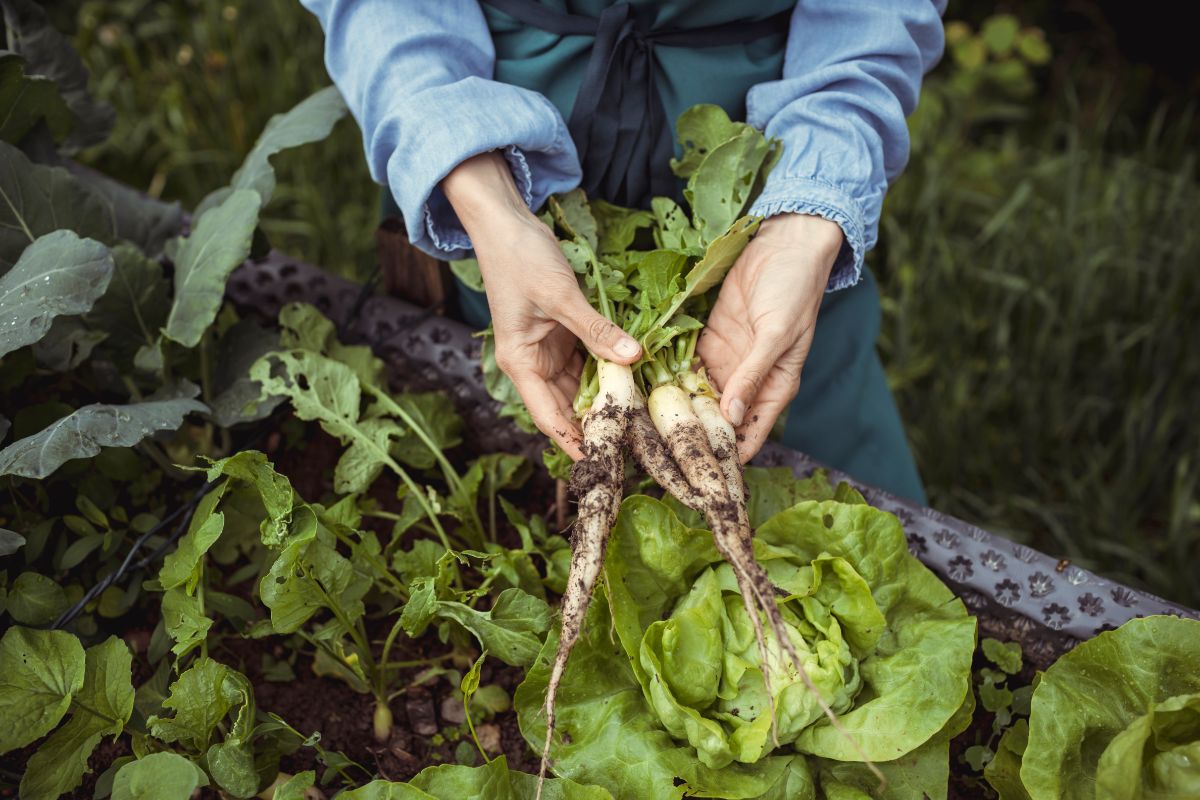
| Plant name: | White Icicle radishes |
| Growing zone: | Zones 2 to 11 |
| Plant type: | Vegetable |
| Top pest control use: | Borers, beetles |
| Recommended companions? | Tomatoes, carrots, squash |
Any radish variety can be useful as a companion plant, but ‘White Icicle’ radishes offer more benefits for the organic garden than most. These radishes are famed for their long and tapering white roots, which can break up tough soils and make it easier for plant roots to grow. More than that, ‘White Icicle’ radishes emit compounds into the soil that can repel many different pests, including cucumber beetles and borers.
Like other radishes, ‘White Icicle’ radishes can also be used as trap crops to lure flea beetles and other pests away from more valuable produce. So, if you’ve ever struggled with holey brassica leaves, you may want to try interplanting some radishes among your broccoli and cabbage! And if you needed more reasons to try out ‘White Icicle’ radishes, these plants also have better heat tolerance than many other radish types, and they can be grown from spring through fall.
7. Borage
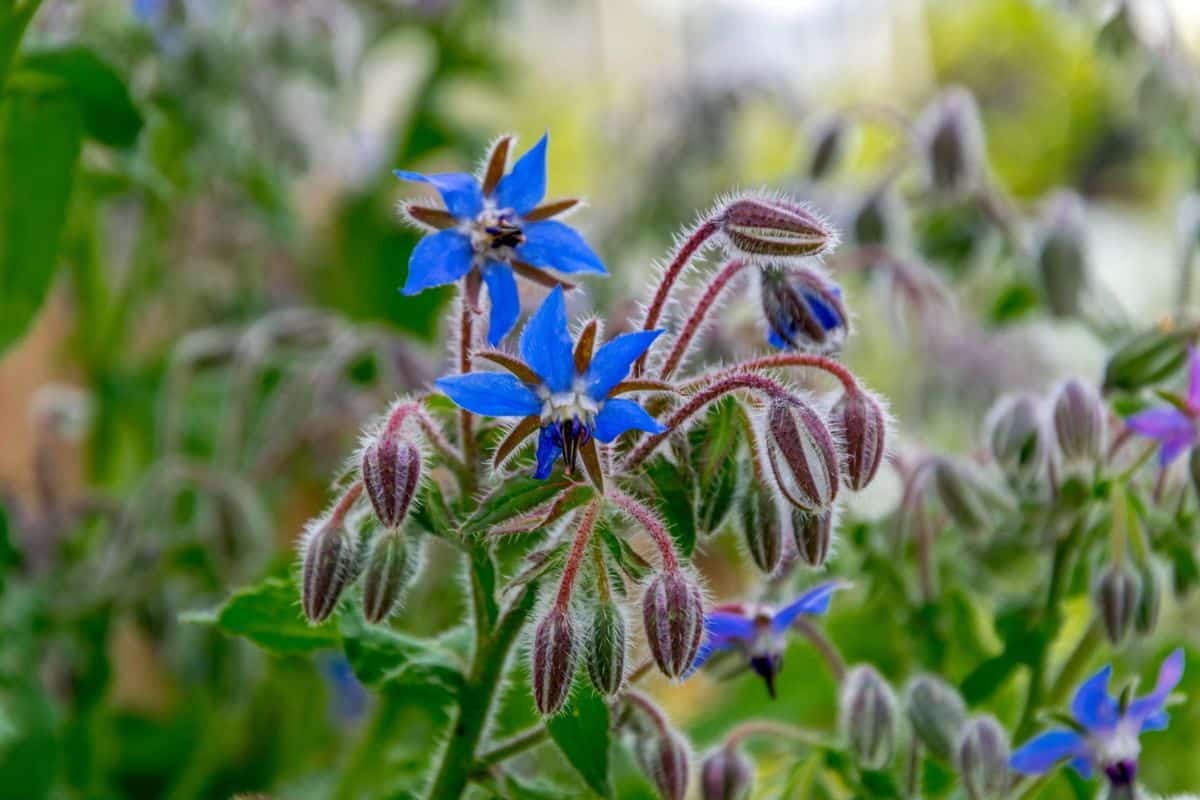
| Plant name: | Borage |
| Growing zone: | Zones 3 to 10 |
| Plant type: | Ornamental; Edible |
| Top pest control use: | Tomato hornworms |
| Recommended companions? | Tomatoes, cucumbers, melons, strawberries |
Borage’s bright blue, star-shaped flowers are a magnet for bees and other pollinators. But borage can also attract predatory wasps to your garden beds, which will prey on a variety of different pests, including tomato hornworms. Not to mention, borage’s scent can distract different pest insects from feeding on your crops, and it may also improve the growth of plants like cucumbers, melons, and brassicas.
Borage will grow happily with many fruits and vegetable plants, but some of the best companion plants for borage include strawberries, tomatoes, and squash. Even if you’re new to gardening, borage is an easy-to-grow plant, and it can be readily propagated from seeds. Like radishes, the long tap roots of borage can break up compacted soil, improving the overall health of your garden and the growth of your plants too!
8. Catnip
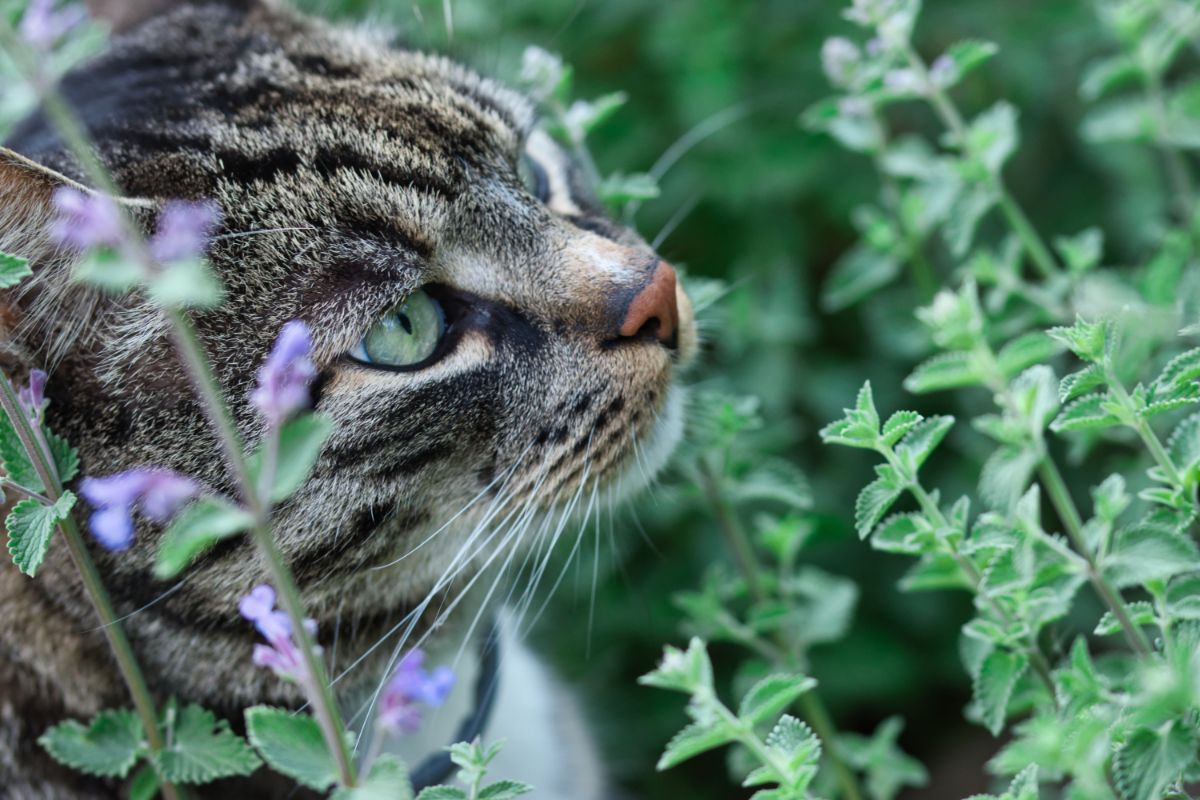
| Plant name: | Catnip |
| Growing zone: | Zones 3 to 9 |
| Plant type: | Herb |
| Top pest control use: | Aphids, squash bugs, mosquitoes |
| Recommended companions? | Brassicas, beans, squash |
Catnip is a fragrant plant in the mint family, which is mostly known for the euphoric effect it creates in cats. But many people don’t know that catnip is also edible for humans, and it makes a delicious herbal tea. Plus, its purple, spire-like flowers have tons of ornamental appeal, and they can draw pollinators to your garden beds and increase your harvest yields.
As a companion plant, catnip repels mosquitoes, as well as various beetle species, aphids, and squash bugs. Potatoes, collard greens, and squash are all suitable mates for catnip, but you may want to grow your catnip in pots in your garden to keep it from spreading. Like other mint plants, catnip can become quite unruly over time, but these plants are much more manageable if you keep them confined in containers or raised beds.
9. Dill
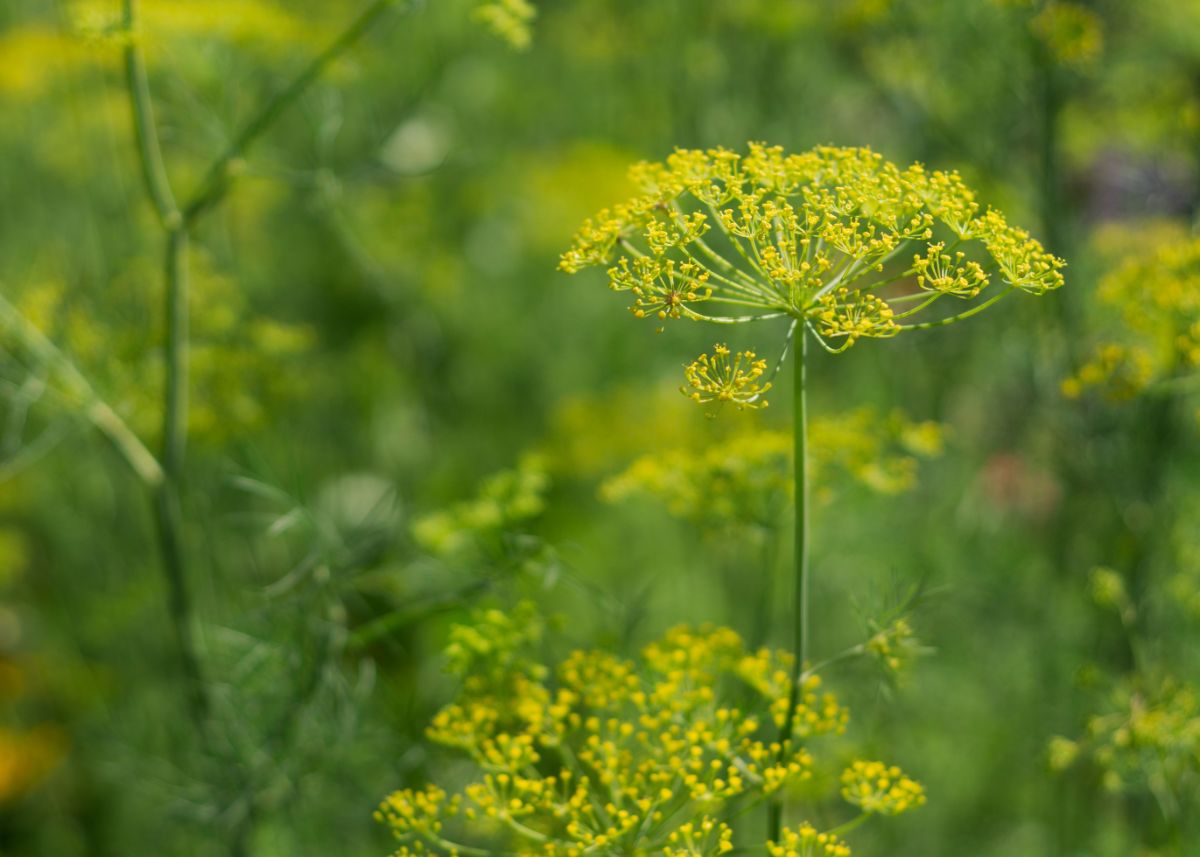
| Plant name: | Dill |
| Growing zone: | Zones 2 to 11 |
| Plant type: | Herb |
| Top pest control use: | Cabbage loopers, aphids, spider mites |
| Recommended companions? | Brassicas, lettuce, cucumbers |
Dill belongs to the Umbellifer family, which also includes plants like carrots, parsley, and fennel. When allowed to flower, Umbellifers like dill are amazing companion plants for many different herbs and vegetables. In fact, growing dill near squash and cucumbers can increase pollination rates and boost your harvest.
What’s more, predatory insects, like wasps, lacewings, and ladybugs, can’t resist dill blooms. So if you want to keep the populations of aphids, spider mites, and cabbage loopers in check, you may want to try interplanting dill in your veggie garden. Companion planting dill with taller plants is also beneficial because the added shade will help prevent dill from bolting as quickly during the summer heat.
10. Yarrow
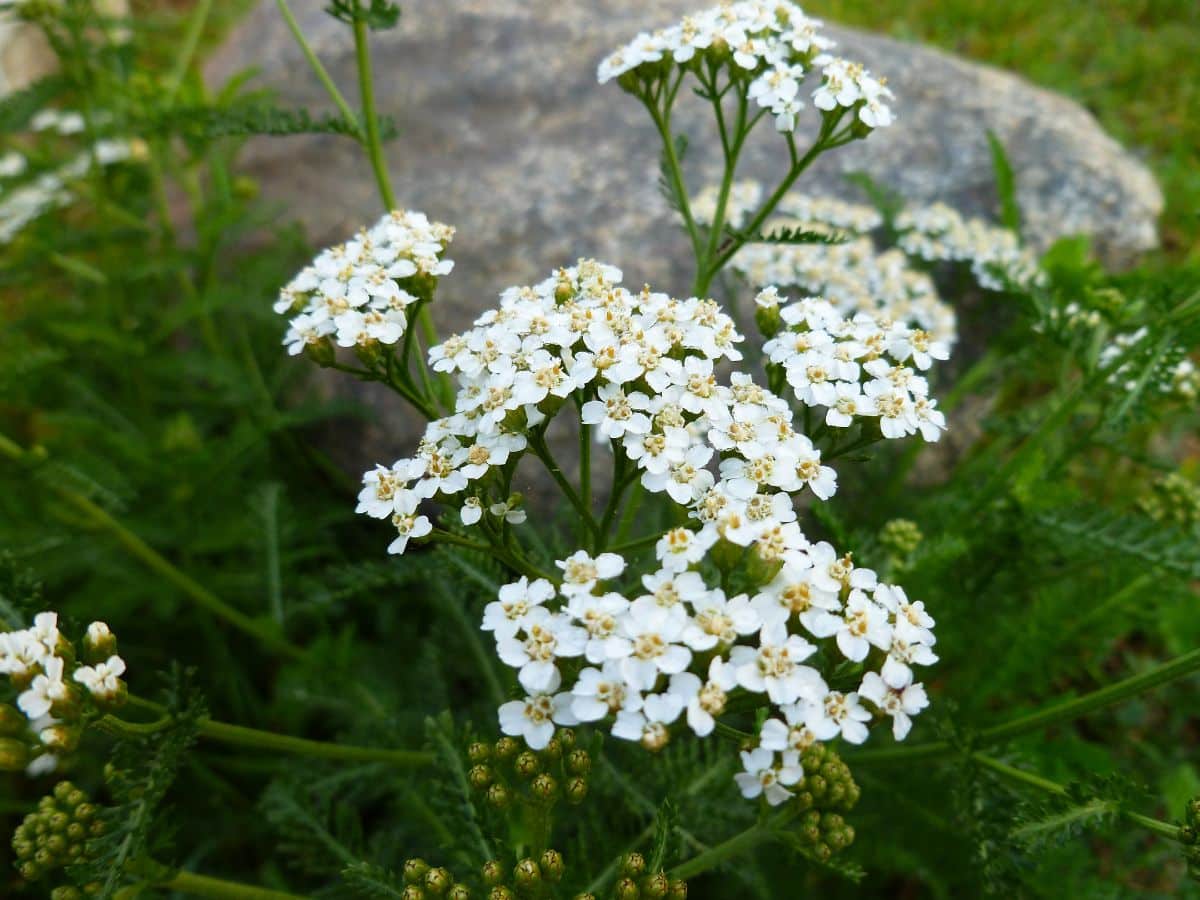
| Plant name: | Yarrow |
| Growing zone: | Zones 3 to 9 |
| Plant type: | Ornamental |
| Top pest control use: | Ants, flies, beetles |
| Recommended companions? | Brassicas, arugula, lavender |
Yarrow is mostly grown as an ornamental plant, but it can also be worked in vegetable gardens. This plant has wide, flat blooms that are highly attractive to pollinators, as well as beneficial insects like predatory wasps and hoverflies. Growing yarrow near vulnerable plants can keep a variety of pests and insects away, and even better, yarrow is also useful for repelling mosquitoes!
Yarrow is a very adaptable plant that can grow in a range of soil types, including sandy and dry gardens. And while yarrow is certainly a hard worker when it comes to policing pests, it’s also highly prized for its feathery leaves and colorful blooms that come in white and various shades of pink and yellow. Yarrow flowers dry beautifully in preserved arrangements, and they also make fantastic cut flowers.
11. Mint
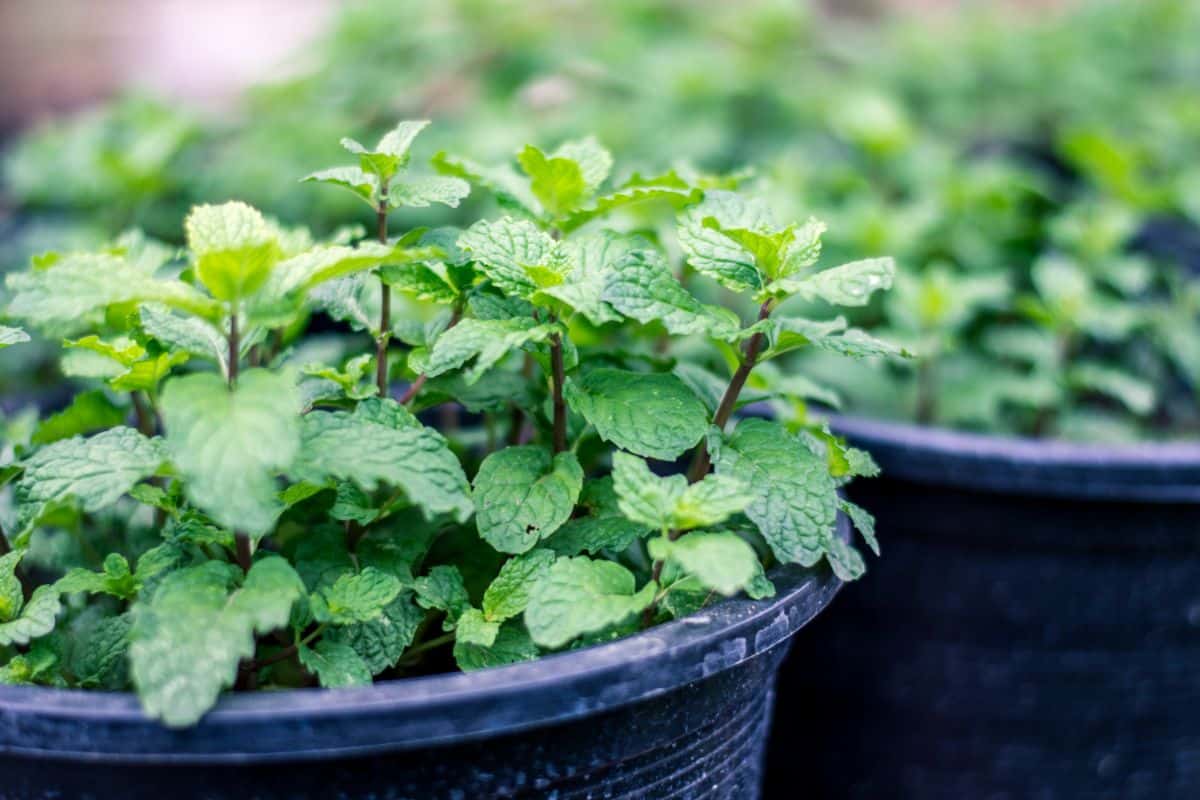
| Plant name: | Mint |
| Growing zone: | Zones 3 to 10 |
| Plant type: | Herb |
| Top pest control use: | Deer, cabbage loopers |
| Recommended companions? | Legumes, tomatoes, brassicas |
Mint is another popular companion plant that’s useful for deterring many different pests, including deer. Planting a ring of mint around your garden can keep deer from browsing your vegetables. Plus, mint can also deter pests like cabbage maggots and cabbage loopers, making it a top companion for plants in the Brassica family, like cabbage, broccoli, and Brussels sprouts.
Of course, mint is also a rather notorious grower, and it can become invasive in many areas. To avoid this, try planting mint in containers and then place your potted mint throughout your garden. This will give you all the companion planting benefits of growing mint without the risk of mint taking over your garden!
12. Russian sage
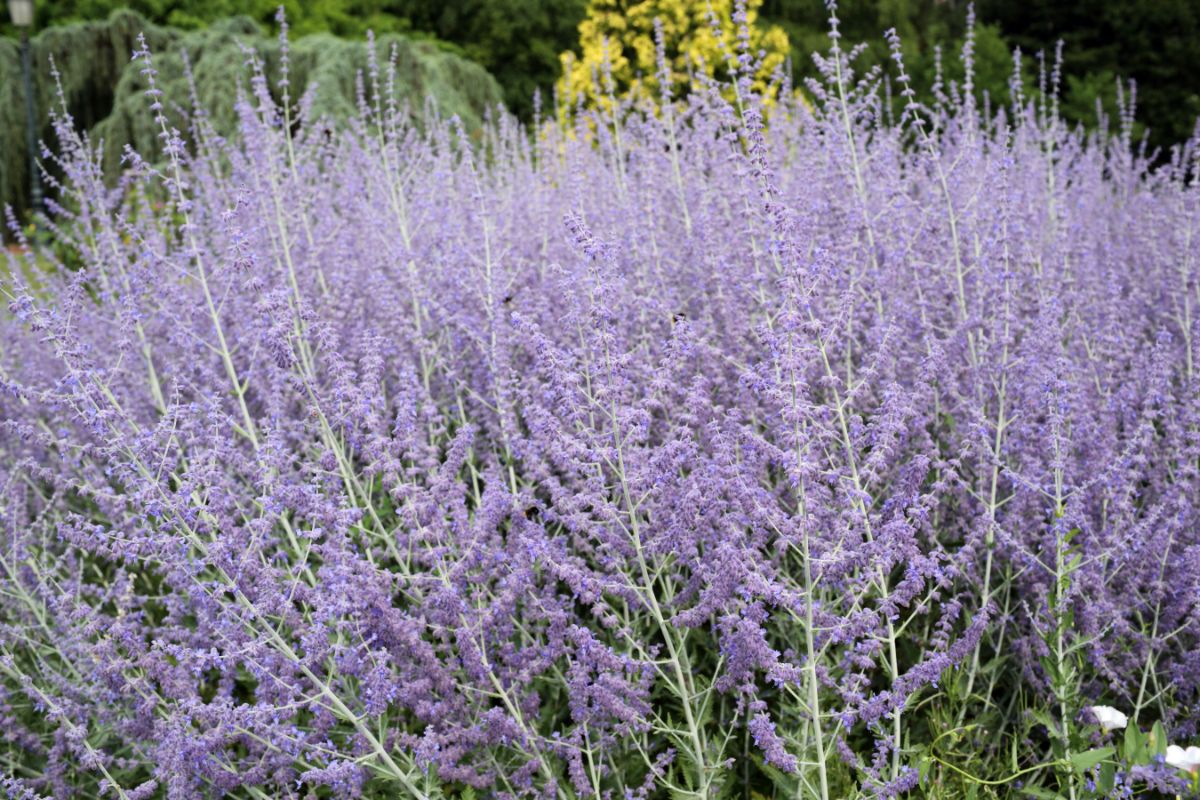
| Plant name: | Russian sage |
| Growing zone: | Zones 4 to 9 |
| Plant type: | Ornamental |
| Top pest control use: | Deer |
| Recommended companions? | Daylilies, phlox, yarrow |
Anyone who’s tried to keep a garden in a deer-prone area knows how damaging deer can be to vegetables and flowers. And while fencing is the best way to keep deer from invading garden spaces, this option can be cost-prohibitive, and it may not be the best choice for all garden spaces. However, one easy alternative is to grow Russian sage around your garden!
Russian sage is another aromatic plant that has a scent that’s reminiscent of sage and lavender. While the fragrance is pleasant to human noses, deer hate it, and they will give Russian sage plants and their companions a wide berth. As an ornamental, Russian sage has lots of aesthetic appeal, and its airy, purple flowers look alluring when paired with yarrow, coneflowers, and other perennial favorites.
13. Oregano

| Plant name: | Oregano |
| Growing zone: | Zones 5 to 10 |
| Plant type: | Herb |
| Top pest control use: | Cabbage loopers, cucumber beetles |
| Recommended companions? | Cucumbers, strawberries, asparagus |
Like other strong-smelling herbs, oregano can repel many different insects, including cucumber beetles and cabbage loopers. Planting oregano near vulnerable plants, like cucumbers and brassicas, is a great way to improve the look and health of your plants while cutting down on your reliance on pesticides. Plus, when oregano flowers, it will lure beneficial insects and pollinators to your vegetables too!
Oregano is easy enough to grow from seed, although most gardeners cultivate oregano either from nursery starts or plant cuttings. Grow oregano in full sun and well-draining soil, and you’ll have a hardy plant that will come back year after year with minimal fuss. Incredibly, in mild climates, oregano can continue to grow throughout the year, and you may even be able to harvest its richly flavored leaves even in mid-winter!
14. Sweet alyssum
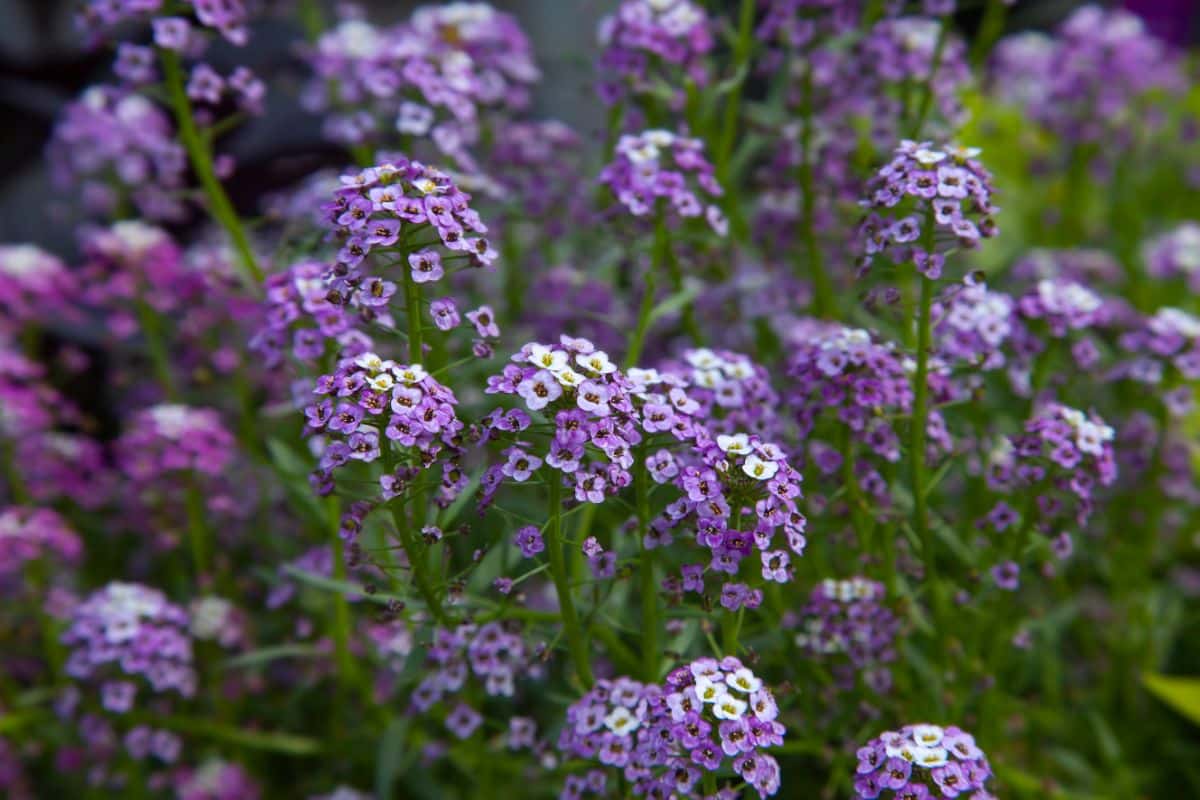
| Plant name: | Sweet alyssum |
| Growing zone: | Zones 9 to 11; Grown as an annual in cooler spots |
| Plant type: | Ornamental |
| Top pest control use: | Aphids |
| Recommended companions? | Tomatoes, brassicas, lettuce |
Sweet alyssum is commonly grown as a container plant as its trailing growth habit makes it a fabulous “spiller” element in mixed planting arrangements. But sweet alyssum can also be cultivated in ornamental beds, and it’s a great, pollinator-friendly groundcover too. Plus, like other pollinator plants, sweet alyssum is ideal for attracting beneficial insects as well.
What beneficial insects will come to your sweet alyssum plants will depend a lot on where you live and the time of the year. But sweet alyssum can draw insects like hoverflies, parasitic wasps, lacewings, and ladybugs, which will feed on insects as varied as caterpillars and aphids. Sweet alyssum’s purple and white flowers bloom primarily in spring and fall, although they may stop flowering during the heat of summer.
15. Sunflowers
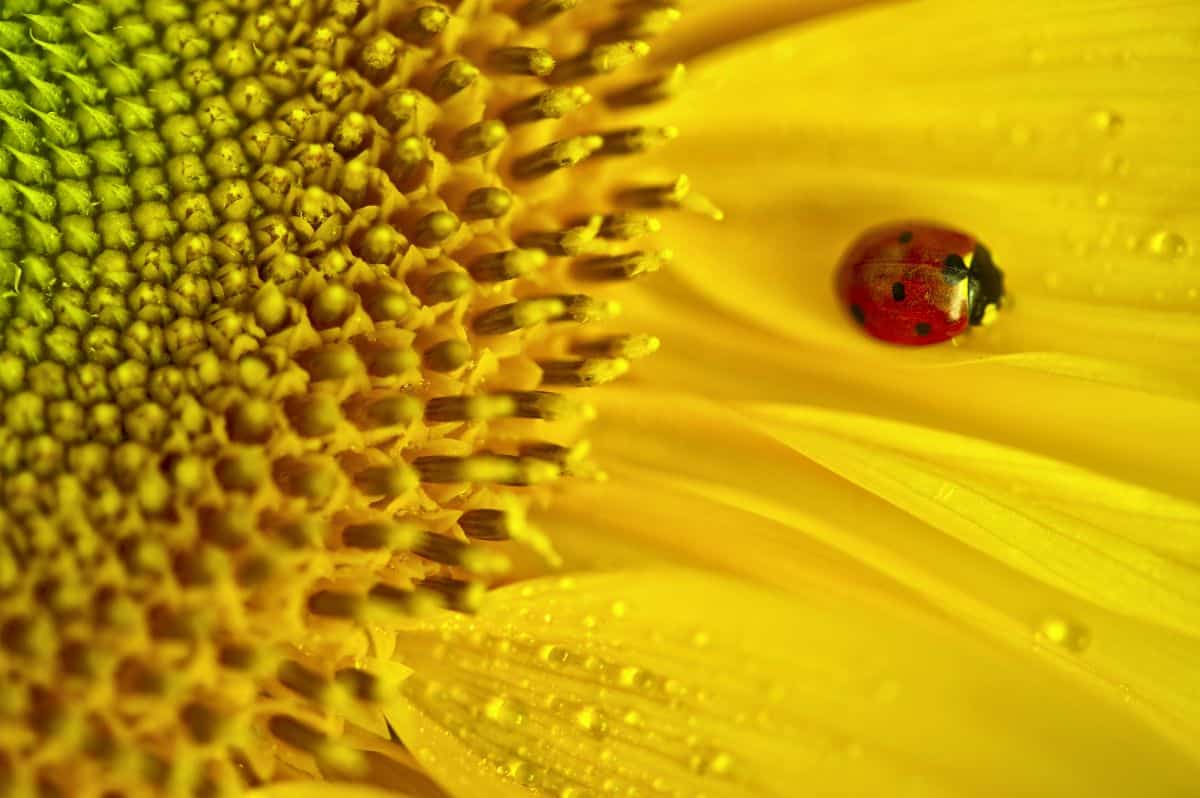
| Plant name: | Sunflowers |
| Growing zone: | Zones 2 to 11 |
| Plant type: | Ornamental; Edible |
| Top pest control use: | Thrips, aphids |
| Recommended companions? | Beans, squash, corn |
Sunflowers are typically used in companion planting to boost pollination rates, but they are also ideal for organic pest control. Sunflowers’ wide-open flowerheads are irresistible to predatory insects, including lacewings and ladybugs, which will feed on thrips and aphids in your garden. Sunflowers can also be used as trap crops to distract pests and draw them away from more valuable produce.
Birds also love sunflower blooms, and growing sunflowers in your garden is an easy way to draw in wild birds. Of course, birds love gobbling up sunflower seeds, but they’ll also feast on beetles, caterpillars, and other pesky insects. Tall sunflowers are a solid choice for larger gardens, but if you’re working with a small space, you can also try out dwarf sunflower varieties, which offer all of the benefits of larger plants but in a pint-sized package!
16. Rosemary
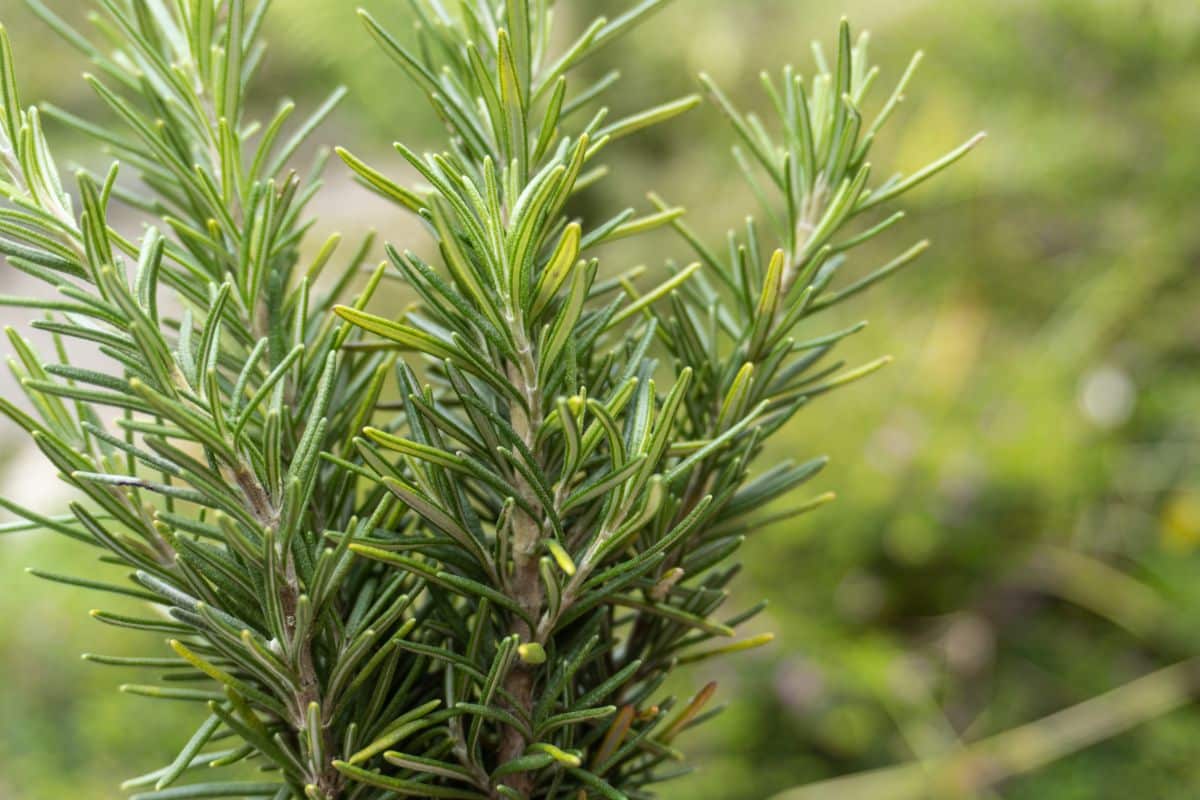
| Plant name: | Rosemary |
| Growing zone: | Zones 8 to 9; Grown as an annual in cooler spots |
| Plant type: | Herb |
| Top pest control use: | Bean beetles, carrot flies, cabbage moths |
| Recommended companions? | Lavender, sage, peppers |
Rosemary is another staple plant in pest-resistant gardens, and it can be used to deter carrot flies, bean beetles, and cabbage moths. Plus, when it’s allowed to bloom, rosemary will also attract beneficial insects to your garden and pollinators too!
Rosemary isn’t as cold-hardy as some of the other herbs on this list, which is why it’s often grown as a container plant or an annual in cool climates. It’s also important to remember that rosemary is a Mediterranean herb that thrives in well-draining soils. For this reason, if you want to grow rosemary as a companion plant, it’s best suited for growing near plants that don’t need lots of water, like peppers, lavender, and sage.
17. Sage

| Plant name: | Sage |
| Growing zone: | Zones 4 to 10 |
| Plant type: | Herb |
| Top pest control use: | Cabbage moths, carrot flies |
| Recommended companions? | Brassicas, strawberries, arugula |
Sage can also repel cabbage moths, but it also does wonders for keeping carrot flies away. If you’ve never encountered these destructive insects, carrot fly larvae can riddle carrot roots with holes, and they also target other members of the Umbellifer family, like parsnips and celery. However, if you grow sage nearby, you can protect your plants and have lots of delicious herbs for roasting with your vegetable harvest too.
Like other Mediterranean plants, sage doesn’t need a lot of water, so it’s important that you don’t overwater your sage if you keep it near water-loving veggies. Culinary sage most often has greyish-green leaves that are quite appealing. But if you want even more garden color, try out variegated, tricolor sage or grow a purple sage plant, which has richly saturated deep purple leaves!
18. Thyme
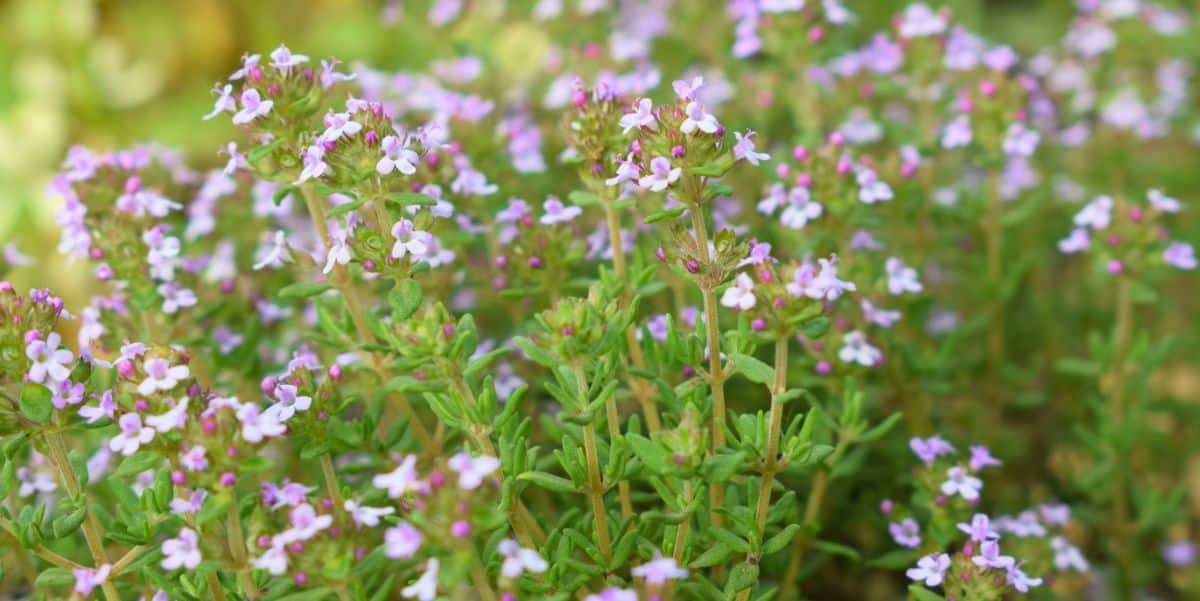
| Plant name: | Thyme |
| Growing zone: | Zones 5 to 10 (most varieties) |
| Plant type: | Herb |
| Top pest control use: | Cabbage worms |
| Recommended companions? | Strawberries, nightshades, blueberries |
By now, you’re probably sensing a theme: strongly scented herbs are some of the best plants you can keep for pest control. Oregano, sage, and rosemary all fall into this category… as does thyme! In the garden, thyme can be used against cabbage worms, and its flowers will attract an assortment of beneficial insects too.
Thyme is a versatile plant that can grow in inground gardens on containers as long as the soil is well draining and not overly soggy. Try planting thyme around your strawberries to keep worms away, or grow it near your nightshade plants to attract predatory wasps that will keep hornworms in check. While common thyme is the most popular thyme variety for backyard gardens, you can also try out more unusual thyme cultivars, like lemon thyme, for an unparalleled flavor that’s ideal for roasted dishes, salads, and more.
19. Horseradish
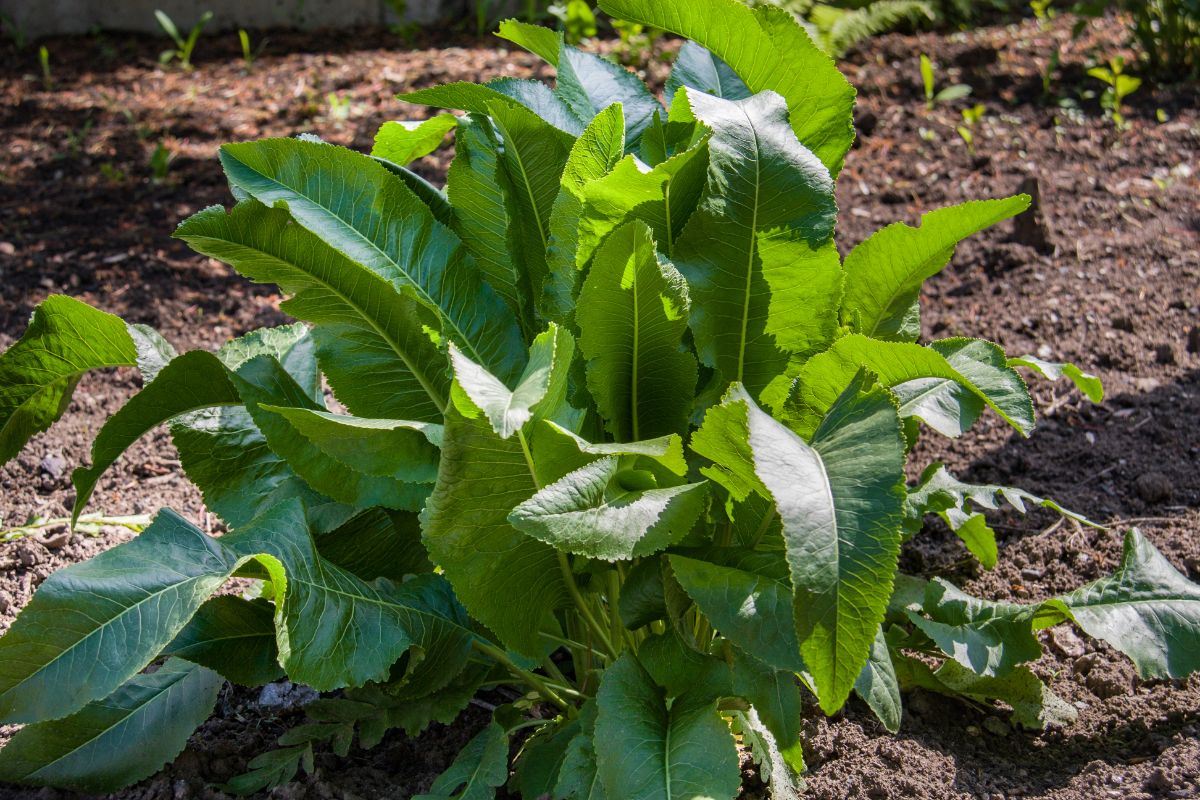
| Plant name: | Horseradish |
| Growing zone: | Zones 4 to 7 |
| Plant type: | Vegetable |
| Top pest control use: | Beetles |
| Recommended companions? | Potatoes, rhubarb, asparagus |
Horseradish is an often overlooked edible plant, but if you love the spicy flavor or you want to try out companion planting, you may want to give it a try. Horseradish can be used to flavor an assortment of sauces, but it also makes a budget-friendly wasabi substitute for homemade sushi. As a companion plant, horseradish’s pungent smell can deter blister beetles and Colorado potato beetles too!
Planting horseradish near potatoes is an excellent way to keep your plants pest-free and boost your tuber crop. However, horseradish is a vigorous grower that grows as a perennial in most areas, so you may want to cultivate it in containers to keep it from spreading. ‘Big Top’ horseradish is a popular variety of horseradish to grow in gardens, and it is often sold as a rootstock in seed catalogs and online.
20. Wormwood
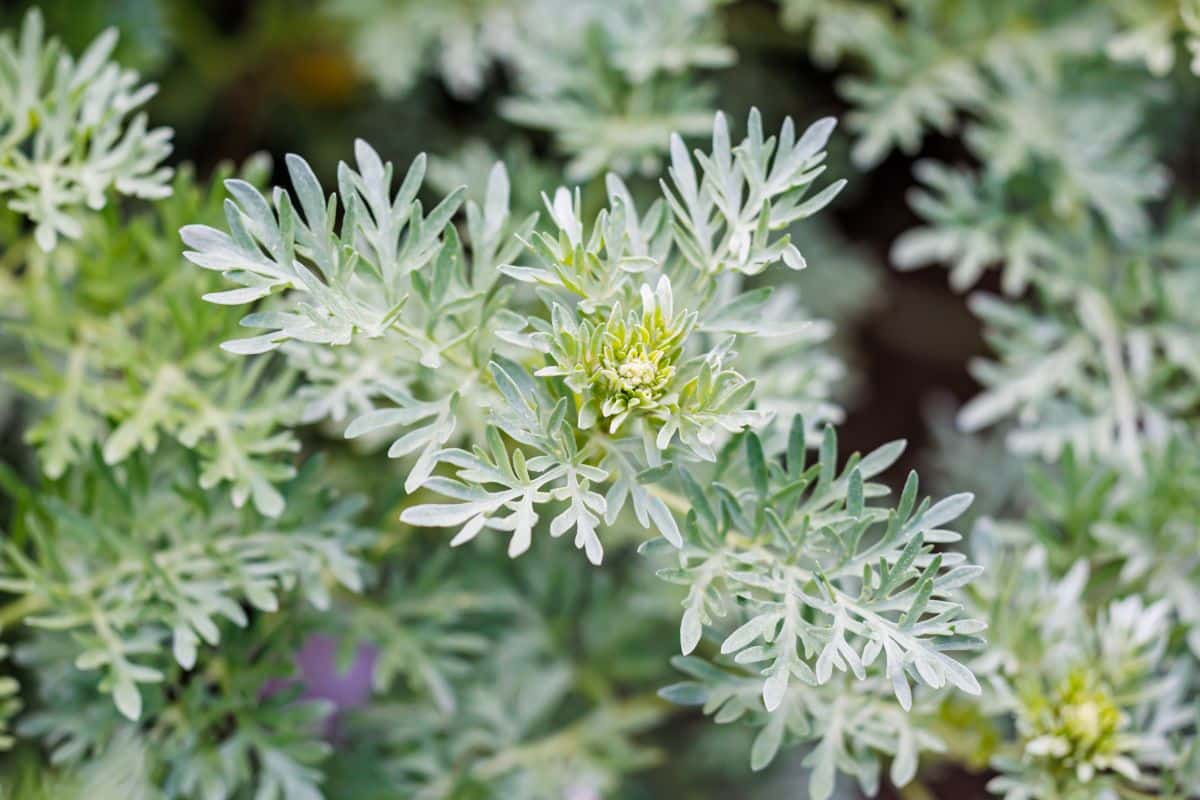
| Plant name: | Wormwood |
| Growing zone: | Zones 4 to 9 |
| Plant type: | Ornamental |
| Top pest control use: | Root maggots, carrot flies |
| Recommended companions? | Rosemary, carrots, onions |
Wormwood is another plant that’s not commonly grown in vegetable gardens, but it is a staple in medicinal herb beds, and its silvery-green leaves also make it a top choice in ornamental gardens. Flies, root maggots, and carrot flies detest the scent of wormwood, and deer and rabbits avoid it too.
Thanks to its strong, sage-like aroma, wormwood is sometimes used in potpourris. However, because this plant is toxic to pets, you may want to avoid growing it if you have cats and dogs roaming your property. Once established, wormwood is hardy, and it doesn’t need much water, which makes it a suitable companion for other plants that like drier conditions, like coneflower, tansy, and yarrow.
Summary
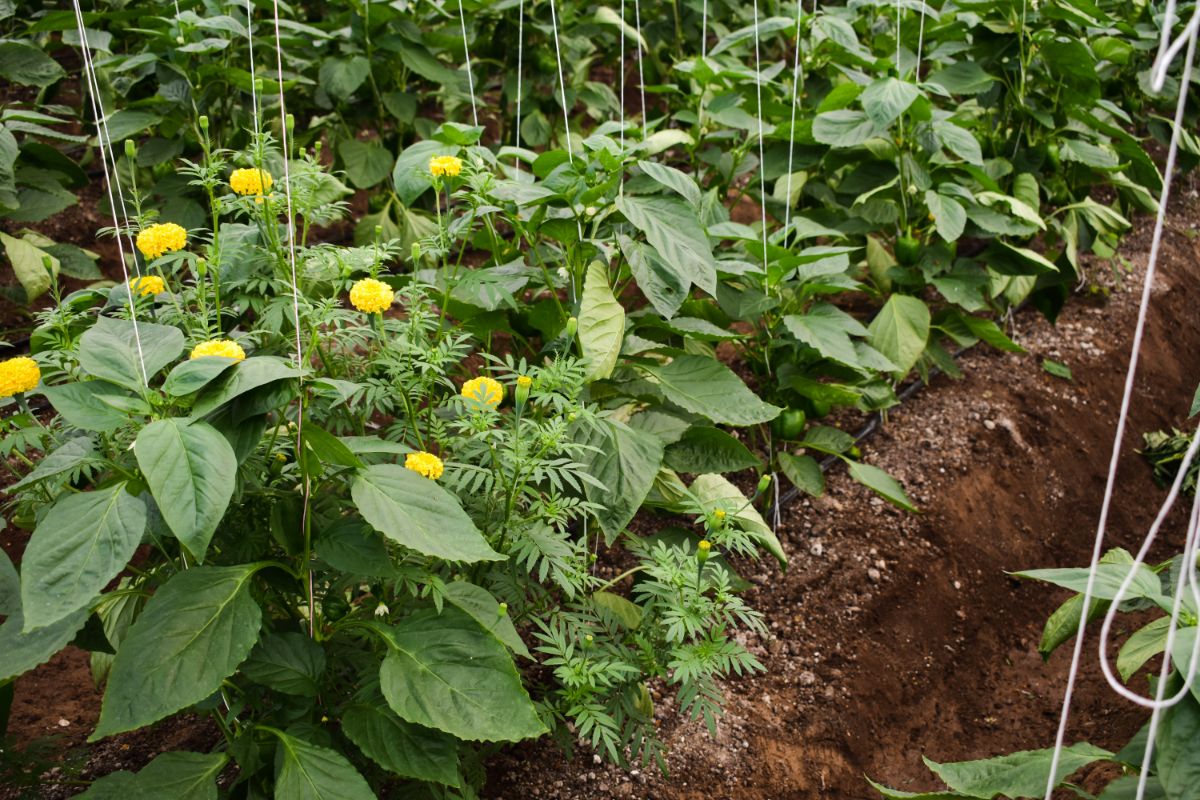
When choosing the right companion plants for your garden, you’ll need to consider the pests you’d like to control, as well as the growing conditions and size of your garden. If you have a small garden or grow veggies in containers, you may want to stick to smaller herbs when companion planting. Conversely, if you have a large vegetable plot, why not try out an assortment of companion plants and take full advantage of strongly scented herbs and plant flowers to lure in beneficial insects too?
To learn more about companion planting, check out our related guides, including the best companion plants for roses and tomatoes.

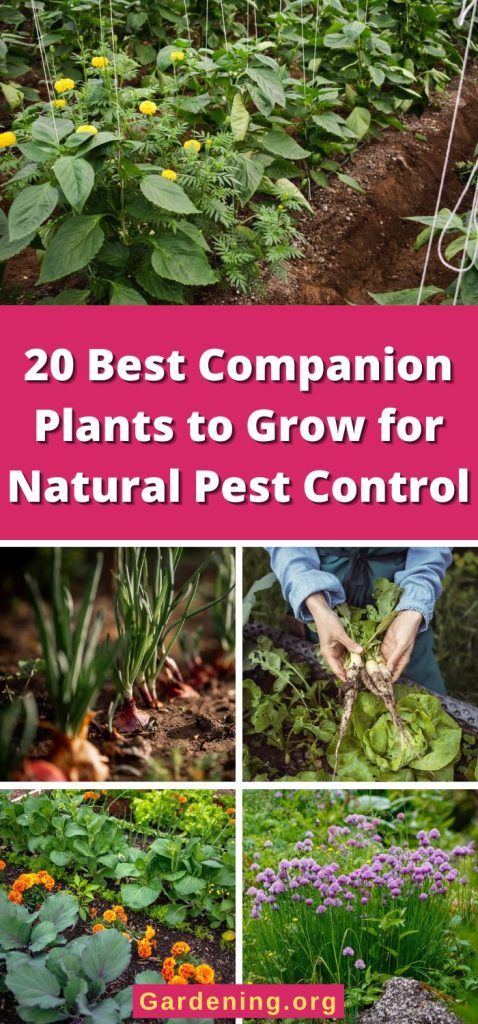
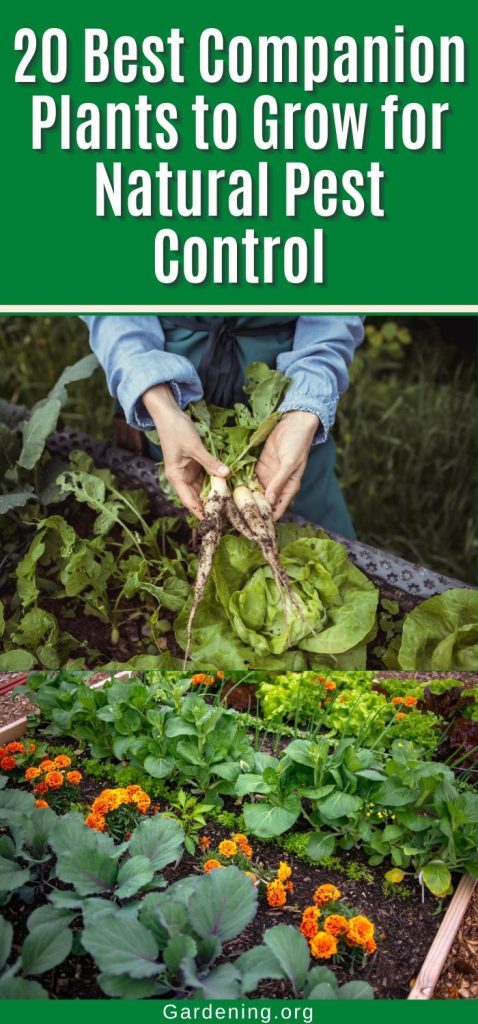
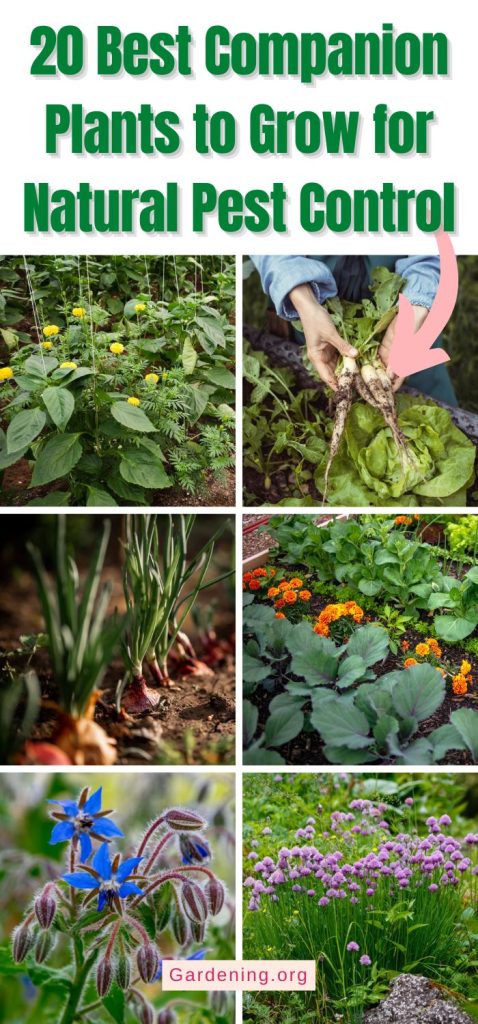
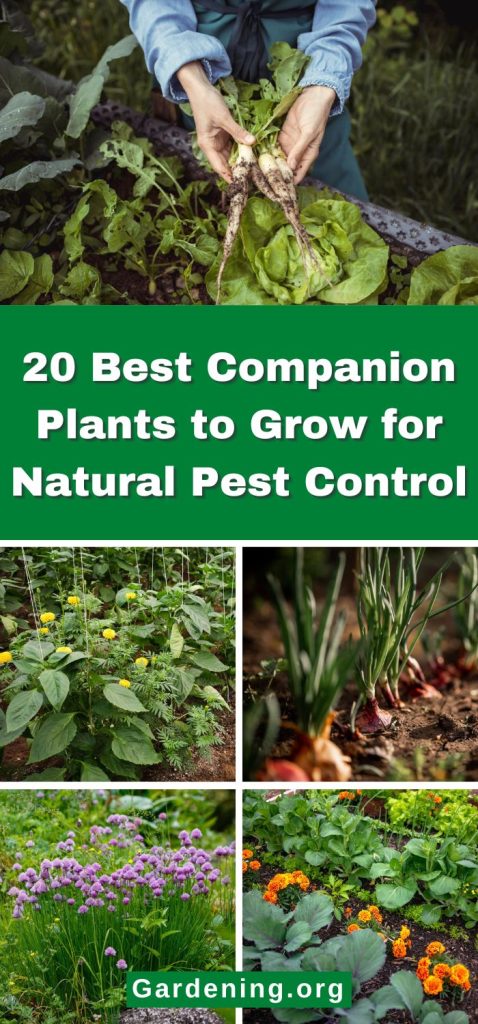

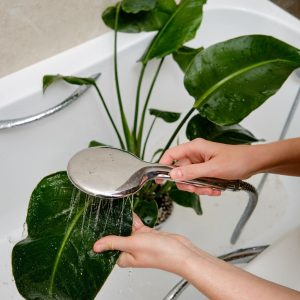

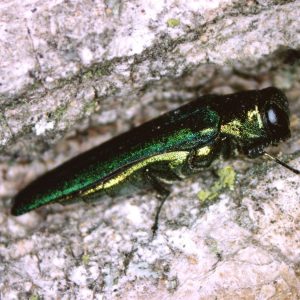
Sharon
I would like to plant a perennial Lavender or Catmint next year . Southern afternoon Sun . Zone 3-4 . Where can I find this in Iowa?
Mary Ward
You could check with your local nurseries. You can also order online from several plant and seed companies, but since you are planning ahead, I would personally suggest starting from seed, especially for the lavender, because it will be much cheaper to grow an amount large enough for a border. These are slow growers when starting from seed, so it would be a good idea to order and start as early as January. Also, start looking for seed clearance sales at your local garden center/seed sellers. They'll still be viable for a January start.
Rosefiend
Here in the next month, you should start seeing catmint and lavender show up at local nurseries in Iowa, such as Earl May's. I like shopping at locally-owned nurseries because the folks there know their stuff and the plants are good for the area. Lavendula angustifolia, aka English lavender, is hardier in this area than the French, Portuguese, or Spanish lavenders.
Good lavender varieties for the Midwest include 'Munstead', 'Hidcote', and 'Betty Blue' -- I believe these are all hardy in zone 5.
Some lavenders do great and then one winter they'll mostly perish. Mulching them well in fall might help keep them viable. They're also slow to get started -- often wait until May to wake up from their long winter's nap.
As far as catmints, any type will do. It's pretty hardy -- it's actually a member of the mint family. I have a little catmint plant that the chickens have repeatedly scratched into bits, but it's coming back this spring despite all that.